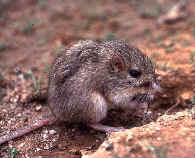
Heteromyidae is a family of rodents consisting of kangaroo rats, kangaroo mice, pocket mice and spiny pocket mice. Most heteromyids live in complex burrows within the deserts and grasslands of western North America, though species within the genus Heteromys are also found in forests and their range extends down as far as northern South America. They feed mostly on seeds and other plant parts, which they carry in their fur-lined cheek pouches to their burrows.

Perognathinae is a subfamily of rodents consisting of two genera of pocket mice. Most species live in complex burrows within the deserts and grasslands of western North America, They feed mostly on seeds and other plant parts, which they carry in their fur-lined cheek pouches to their burrows.

Chaetodipus is a genus of pocket mouse containing 17 species endemic to the United States and Mexico. Like other members of their family such as pocket mice in the genus Perognathus, they are more closely related to pocket gophers than to true mice.

The desert pocket mouse is a North American species of heteromyid rodent found in the southwestern United States and Mexico. True to its common name, the medium-sized desert pocket mouse prefers sandy, sparsely vegetated desert environments.
Lemniscomys linulus, commonly known as the Senegal grass mouse or Senegal one-striped grass mouse, is a species of rodent in the family Muridae. It is found in Ivory Coast, Guinea, Mali, and Senegal and its natural habitat is dry savanna. At one time considered to be a subspecies of Lemniscomys griselda, it is now accepted as a species in its own right.
The narrow-skulled pocket mouse is a species of rodent in the family Heteromyidae. It is endemic to western Mexico, living west of the Sierra Madre Occidental crest.

The California pocket mouse is a species of nocturnal and primarily solitary rodent in the family Heteromyidae.
Goldman's pocket mouse is a species of rodent in the family Heteromyidae. It is endemic to Mexico, where it is threatened by the increasing conversion of its dry, scrubby habitat into agricultural land. As a result, the International Union for Conservation of Nature has assessed its conservation status as being "near threatened".

Nelson's pocket mouse is a species of rodent in the family Heteromyidae. It is found in Mexico and in New Mexico and Texas in United States. It is named in honor of the American naturalist Edward William Nelson.

The Sinaloan pocket mouse is one of 17 species of pocket mice in the genus Chaetodipus. Two subspecies of C. pernix are recognized, C. p. pernix and C. p. rostratus, all are endemic to Mexico.

The spiny pocket mouse is a species of rodent in the family Heteromyidae and order Rodentia. It is found in Baja California in Mexico and in Arizona, California and Nevada.

The Mexican spiny pocket mouse is a species of rodent in the family Heteromyidae. It is native to Mexico and Texas in the United States where it is found in dry, scrubby habitats. The IUCN has assessed it as being of "least concern". It was formerly placed in the genus Liomys, which is now recognized to be paraphyletic and has been subsumed into Heteromys.
The painted spiny pocket mouse is a species of rodent in the family Heteromyidae. It is found in Mexico and the northern tip of Guatemala. It was formerly placed in the genus Liomys, which is now recognized to be paraphyletic and has been subsumed into Heteromys.

The olive-backed pocket mouse is a species of rodent in the family Heteromyidae. It is found in the central Great Plains of Canada and the United States where it is widespread and relatively common; the IUCN considers it to be of "least concern".

The silky pocket mouse is a species of rodent in the family Heteromyidae. It is found in northern and central Mexico and the southwest region of the United States. It is a species of least concern, according to the IUCN, with no known major threats. The silky pocket mouse eats seeds, succulent parts of plants and nuts, and carries food in its cheek pouches. It lives in low valley bottoms with soft soils, among weeds and shrubs, where it burrows in the sand to bury seed caches. The species is more tolerant of harsh habitat conditions than other pocket mice.
The San Joaquin pocket mouse or Salinas pocket mouse is a species of rodent in the family Heteromyidae. It is endemic to California in the United States where it lives in desert and semi-desert habitats.

Merriam's pocket mouse is a species of rodent in the family Heteromyidae. It is found in northeast Mexico and New Mexico, Oklahoma and Texas in the United States. Its habitat is shortgrass prairie, desert areas with scrub and arid shrubland. The species is named to honor Clinton Hart Merriam, a biologist who first described several other members of the genus Perognathus, and first elucidated the principle of a "life zone" as a means of characterizing ecological areas with similar plant and animal communities.

The Pacific pocket mouse, Perognathus longimembris pacificus, is endemic to California. It lives in sandy coastal soils of the coastal sage scrub ecoregion. It eats seeds and some insects. It was believed to be extinct until 1993, when a small population was discovered. It is now a federally listed Endangered animal species.
The Chihuahuan pocket mouse is a species of heteromyid rodent found in the southwestern United States and Mexico. It was formerly considered a subspecies of the desert pocket mouse, but was determined to be a distinct species in 1996, following analysis of its mitochondrial DNA.
The lined pocket mouse is a species of rodent in the family Heteromyidae. This pocket mouse is endemic to a small area of central Mexico.












